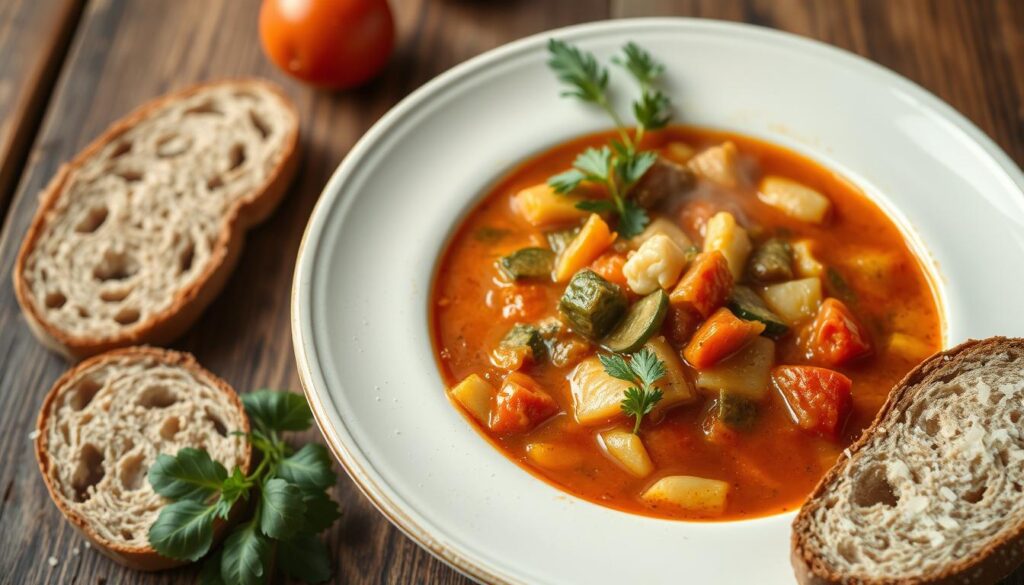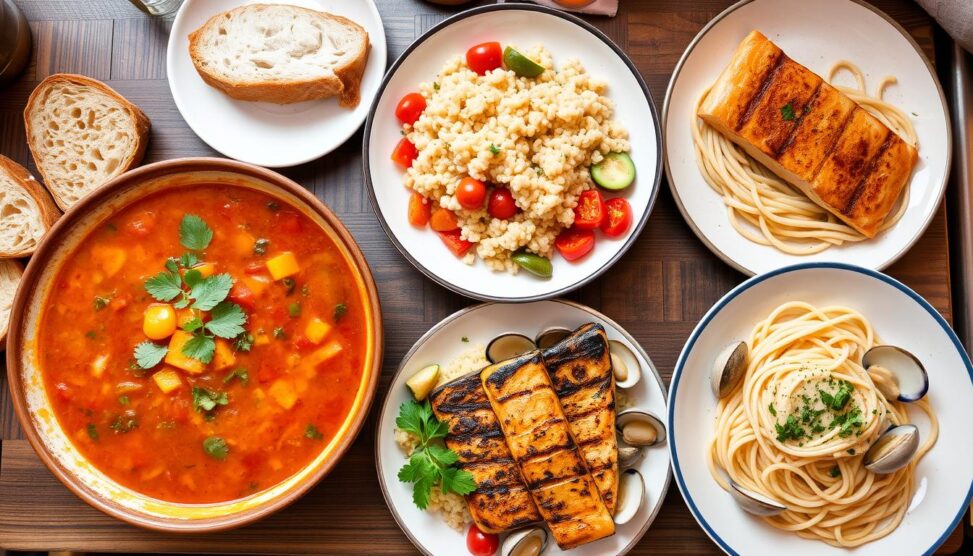Italian cuisine can be both delicious and heart-healthy. Discover how to blend rich Italian flavors with heart-healthy eating principles. Let’s explore healthy Italian recipes that will transform your approach to Mediterranean cooking.
Italian food is known for its bold flavors and comfort. Many traditional recipes can be adapted for better heart health. By using fresh ingredients and lean proteins, you can create heart-healthy Italian meals that satisfy.
We’ll guide you through various options that prove healthy eating can be tasty. Learn how simple swaps can turn favorite Italian dishes into heart-friendly meals. From nutrient-rich salads to soul-warming soups, there’s something for everyone.
Key Takeaways
- Italian cuisine can be adapted for heart health without losing flavor
- Fresh ingredients and lean proteins are key to heart-healthy Italian cooking
- Whole grain pasta alternatives offer higher fiber content
- Vegetable-based dishes like zucchini noodles significantly reduce carbohydrate intake
- Mediterranean diet-inspired meals can lower heart disease risk by up to 30%
- Many heart-healthy Italian recipes contain fewer than 400 calories per serving
- Consumer interest in healthy Italian options has risen by 55%
Introduction to Heart-Healthy Italian Cuisine
Italian cuisine blends flavors with health benefits. The Mediterranean diet, the base of Italian cooking, promotes heart health. In 2022, it ranked as the best diet for heart and overall well-being.
Healthy Italian meals use fresh, quality ingredients. Olive oil, a key component, is rich in heart-healthy fats. It reduces inflammation and protects against cardiovascular diseases. Italy, a major producer, harvested 366,000 tonnes of olive oil in 2019-20.
Heart-healthy Italian recipes use vegetables, whole grains, and lean proteins. These provide essential nutrients that support heart health. The Mediterranean diet pyramid suggests a specific eating pattern.
- A base of vegetables, fruits, whole grains, legumes, nuts, and seeds
- Fish and seafood twice a week
- Moderate portions of dairy and poultry
- Limited red meat consumption
These principles create tasty Italian meals that nourish your heart. Italian cuisine offers many options for a heart-healthy diet. You can enjoy colorful salads, hearty soups, and flavorful pasta dishes.
Fresh Ingredients for a Heart-Healthy Meal
Italian cuisine thrives on fresh, seasonal ingredients. Heart-healthy Italian recipes begin with the right components. Whole grains, lean proteins, and colorful veggies form the base of nutritious Italian dishes.
Seasonal vegetables add flavor to healthy meals. Try these options:
- Bell peppers in a colorful peperonata
- Leafy greens like arugula in a zesty salad
- Zucchini in a light pasta primavera
Replace refined carbs with whole grains for more fiber and nutrients. Whole wheat pasta, farro, and brown rice are great choices. For protein, fish and legumes excel in Italian cooking.
Grilled tuna steak on fettuccine offers 42g of protein per serving. A hearty minestrone soup provides 8g of protein and 7g of fiber per cup.
Extra virgin olive oil is essential in Italian cuisine. It’s rich in antioxidants and perfect for salads or sautéing veggies. High-quality ingredients can transform simple dishes into extraordinary meals.
Flavorful Sauces That Promote Heart Health
Italian cuisine offers many heart-healthy sauce options. Tomato-based sauces are excellent for heart health. They’re rich in lycopene, a powerful antioxidant.
Homemade marinara sauce is better than store-bought versions. It has less sodium and no added sugars. This makes it a healthier choice.
When preparing your own sauce, consider these healthy Italian cooking tips:
- Use canned tomatoes for year-round consistency
- Add 2-3 tablespoons of basil and oregano for flavor
- Simmer for 45 minutes to achieve desired thickness
- Opt for lean proteins like ground turkey instead of beef
Pesto is another heart-friendly sauce option. Try using walnuts or almonds instead of pine nuts. This can increase its nutritional value.
Olive oil is a key ingredient in many Italian sauces. It’s full of monounsaturated fats that support heart health. Remember to control portions.
A typical serving size is half a cup. This contains about 70-100 calories. Making your own sauces lets you control the ingredients. This ensures a tasty and heart-healthy meal.
Wholesome Italian Salads
Italian cuisine boasts heart-healthy dishes, including delicious salads. These nutritious options are ideal for those looking to improve their heart health. Let’s discover some tasty Italian salads that nourish your body and delight your taste buds.
The Healthy Italian Pasta Salad is a standout choice. It takes just 15 minutes to make and serves four people. This dish combines short pasta, chickpeas, and cherry tomatoes.
Cucumbers, black olives, and marinated artichokes add diverse flavors and textures. To make it even healthier, use whole grain pasta and add arugula. Dress with extra virgin olive oil and lemon juice for extra zest.
- Use whole grain pasta for added fiber
- Incorporate 2 big handfuls of arugula for extra nutrients
- Dress the salad with 4-5 tablespoons of heart-healthy extra virgin olive oil
- Add a splash of lemon juice for a zesty flavor boost
The Melon and Prosciutto Salad is another great option. It’s light and satisfying with only 186 calories per serving. For vegetarians, try the Arugula Salad, packed with flavor at 181 calories per cup.
These Italian salads are perfect for various occasions. They’re great for BBQs, picnics, or beach outings. With a 4.42-star rating, these recipes are sure to become your new favorites.
Delicious Pasta Alternatives
Searching for tasty, heart-healthy Italian meals? These pasta alternatives are both delicious and nutritious. Whole wheat pasta offers more fiber and nutrients than regular pasta. It’s great for flavorful, heart-healthy Italian recipes.
Spiralized vegetables provide a satisfying low-carb option. Zucchini noodles, or “zoodles,” pair well with Italian sauces. They cook fast, making them perfect for quick weeknight dinners.
Quinoa and brown rice can replace pasta in many dishes. These grains add protein and fiber to your meals. Try quinoa “risotto” or brown rice “pasta” salad for a nutritious Italian twist.
- Spaghetti squash: A low-carb, gluten-free pasta substitute
- Whole wheat linguine: Adds extra flavor and texture to BLT-inspired dishes
- Vegetable-based pastas: Incorporate spinach or fresh chard for added nutrition
These options support heart health and add variety to your diet. They let you enjoy Italian flavors while nourishing your body. Try different combinations to find your new favorite healthy Italian meal.
Hearty Soups for a Nourishing Meal

Italian cuisine offers warm, comforting soups packed with nutrients. These hearty soups provide nutritious and delicious meals. Let’s explore some healthy Italian cooking tips for nourishing dishes.
Minestrone soup is a classic, veggie-packed dish. It’s low in calories but high in flavor. Mix seasonal vegetables, beans, and whole-grain pasta for a filling meal.
A Healthy Italian Wedding Soup is a protein-rich option. This recipe makes 6 servings with the following nutrition per serving:
- 305 calories
- 30g carbohydrates
- 30g protein
- 8g fat
- 3g fiber
The soup contains 40-50 mini meatballs made from extra lean ground beef. This promotes heart health with lower saturated fat. It’s quick to make, taking only 25 minutes.
For a vegetarian option, try lentil soup with Italian herbs. French green lentils keep their shape during cooking. This protein-packed soup makes a comforting, heart-healthy meal.
Focus on fresh ingredients and herbs for flavor. Avoid excess salt or fat when cooking. These tips will help you create tasty, heart-healthy Italian soups.
Flavorful Seafood Dishes
Seafood shines in heart-healthy Italian recipes. It’s packed with omega-3 fatty acids, making it ideal for heart-conscious eaters. Let’s explore some tasty Italian-inspired seafood dishes.
Grilled salmon is a top choice. Seasoned with Italian herbs, it’s simple yet delicious. Try a lighter shrimp scampi with whole grain pasta and less butter.
Clams and mussels in tomato broth are nutrient-rich and low-calorie. This dish is perfect for those watching their weight without compromising flavor.
- Teriyaki Cedar Plank Salmon (35 minutes, serves 4)
- Sesame Crusted Tuna (15 minutes)
- Slow Roasted Citrus Salmon (45 minutes, serves 2)
- Salt Baked Trout (30 minutes, serves 4)
Seafood is a great protein source. It helps maintain muscle health, especially for adults over 30. Aim for 10-35% of your daily calories from protein-rich foods.
Lean Proteins in Italian Cooking
Italian cuisine offers many heart-healthy meals rich in lean proteins. Chicken breasts, seafood, and legumes are great choices. These ingredients have less saturated fat than pork or beef.
Seafood lovers can enjoy clams or mussels. These pack 10 to 15 grams of protein per serving. Try Red Clam Sauce with linguine for a tasty, heart-healthy meal.
Plant-based proteins are also common in Italian cooking. Whole wheat pasta has 6 grams of protein per serving. Red lentil pasta offers even more, with up to 13 grams.
- Grilled Basil Chicken and Tomatoes: 177 calories, 5g fat, 24g protein
- Rosemary Chicken with Spinach & Beans: 348 calories, 9g fat, 41g protein
- Tuna Steak on Fettuccine: 505 calories, 17g fat, 42g protein
You can enjoy tasty Italian dishes while supporting your heart health. Use lean proteins and healthy cooking methods like grilling and baking.
Low-Fat Italian Desserts
Italian desserts can be both delicious and heart-healthy. Fresh fruits star in many low-fat Italian sweets. These treats offer natural sweetness without added sugars.
Try fresh berries with balsamic reduction for a simple, elegant dessert. This combo delights your taste buds without extra fats. For a creamy treat, make lighter cheesecake using ricotta cheese.
Dark chocolate and nuts can be part of heart-healthy Italian desserts. Create dark chocolate-dipped almonds or hazelnuts for a satisfying treat. These bites are rich in antioxidants and healthy fats.
- Fresh fruit desserts: 58 calories per serving
- Ricotta cheesecake: 180 calories per slice
- Dark chocolate and nut bites: 93 calories per 2 pieces
These lighter options align with heart health goals. They provide a sweet finish to Italian meals. You can enjoy these treats while maintaining your well-being.
Meal Planning for Heart Health
Italian meal plans can be both heart-healthy and delicious. The best recipes focus on lean proteins, whole grains, and plenty of vegetables. A balanced Italian plate includes 15% protein, 30% healthy fats, and 50% carbohydrates.
Olive oil is a key ingredient in healthy Italian cooking. It can reduce heart disease risk by 30% when part of an antioxidant-rich diet. Roasting and grilling can cut fat content by 20% compared to frying.
Choose lean proteins like fish or chicken for your meals. Swap regular pasta for whole wheat varieties to increase your fiber intake. These simple changes can make a big difference in your heart health.
Batch cooking heart-healthy Italian dishes can save time and promote nutritious eating habits. Bulk-buying staples like quinoa or farro can reduce costs by 10-15%. Include seasonal fruits and vegetables in your meal plan.
Seasonal produce is 20-30% cheaper and packed with nutrients. These foods can lower cardiovascular disease risk by up to 30%. They’re a smart choice for both your health and wallet.
Share your meals with loved ones, following Italian tradition. Family dinners with wholesome, flavorful dishes nurture both heart and relationships. This approach creates a satisfying and enjoyable meal plan that’s good for your heart.





Leave a Reply